I have 29,938,766 rows inside the VISITS table and the table looks like this
| USER_ID (INT) | VISITED_IN (DATETIME) |
|---|---|
| 65 | 2020-08-26 07:57:43 |
| 1182 | 2019-03-15 02:46:48 |
| 1564 | 2015-07-04 10:59:44 |
| 73 | 2021-03-18 00:25:08 |
| 3791 | 2017-10-17 12:22:45 |
| 51 | 2022-05-02 19:11:09 |
| 917 | 2017-11-20 15:32:06 |
| 3 | 2019-12-29 15:15:51 |
| 51 | 2015-02-08 17:48:30 |
| 1531 | 2020-08-05 08:44:55 |
| Etc... | Etc... |
When running this query, It takes 17-20 seconds and returns 63,514 (The user has 63,514 visits)
SELECT COUNT(*) FROM VISITS WHERE USER_ID = 917
When running this query, It takes 17-20 seconds and returns 193 (The user has 193 visits)
SELECT COUNT(*) FROM VISITS WHERE USER_ID = 716
The problem is the query always takes between 17-20 seconds for 29,938,766 rows even if the user has only 3, 50, 70, or 1,000,000 visits.
I think the problem is because it is looping for all rows?
The second query must be faster than the first query. It depends on the number of rows. But both queries take the same time!
What do you suggest to me to avoid this problem?
Table structure
Update: Here is a new suggested scenario:
When a user enters his or others' profile, He can see the number of profile visits and he can filter visits using this way
Last 24 hours
|
---> SELECT COUNT(*) FROM VISITS WHERE USER_ID = 5 AND VISITED_IN >= DATE_SUB(NOW(), INTERVAL 1 DAY);
Last 7 days
|
---> SELECT COUNT(*) FROM VISITS WHERE USER_ID = 5 AND VISITED_IN >= DATE_SUB(NOW(), INTERVAL 7 DAY);
Last 30 days
|
---> SELECT COUNT(*) FROM VISITS WHERE USER_ID = 5 AND VISITED_IN >= DATE_SUB(NOW(), INTERVAL 30 DAY);
All time
|
---> SELECT VISITS FROM USERS WHERE USER_ID = 5;
Also, I'll create a recurring event that executes this command every day.
DELETE FROM VISITS WHERE VISITED_IN <= DATE_SUB(NOW(), INTERVAL 30 DAY);
Also, I'll make sure to increase the VISITS column when adding a new row in the VISITS table.
UPDATE USERS SET VISITS = VISITS + 1 WHERE ID = 5

